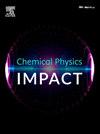揭示配体结构在调节手性铕络合物发光中的作用
IF 4.3
Q2 CHEMISTRY, PHYSICAL
引用次数: 0
摘要
圆极化发光(CPL)是指手性发光材料在特定方向上发出优先偏振光的现象。这种特性源于手性配体与镧系离子的相互作用,诱导手性进入发光中心,在信息存储、光电器件和生物成像方面具有潜在的应用前景。本文报道了以3-(+)-三氟乙酰樟脑酸酯(tfc)手性配体和三苯基氧化膦配体(DPT)为原料合成铕配合物[Eu(+tfc)3(DPT)](H2O)2。通过元素分析,¹H和³¹P NMR, FTIR, TGA和XRD对化合物进行了表征。[Eu(+tfc)3(DPT)](H2O)2配合物的绝对量子产率为2.6%,寿命为0.323 ms, CPL不对称系数为0.038,具有优异的热稳定性,最高可达320°C。然而,配体与铕离子之间的能量失配导致了非辐射衰变和发光效率降低。这种不匹配归因于配体的无定形性质和旋转自由。新型三苯基氧化膦配体增强了光物理性质,突出了该配合物在cpld相关应用中的潜力,但需要进一步优化。本文章由计算机程序翻译,如有差异,请以英文原文为准。

Unraveling the role of ligand structure in modulating chiral europium complex luminescence
Circularly Polarized Luminescence (CPL) is a phenomenon where chiral luminescent materials emit light preferentially polarized in a specific direction. This property arises from the interaction of chiral ligands with lanthanide ions, inducing chirality into the luminescent center, with potential applications in information storage, optoelectronic devices, and bioimaging. This study reports the synthesis of a europium complex, [Eu(+tfc)3(DPT)](H2O)2, incorporating a 3-(+)-trifluoroacetyl camphorate (tfc) chiral ligand and a triphenylene phosphine oxide ligand (DPT) adopting the well-established method. The compound is characterized using elemental analysis, ¹H and ³¹P NMR, FTIR, TGA, and XRD. The [Eu(+tfc)3(DPT)](H2O)2 complex exhibits photoluminescence with an absolute quantum yield of 2.6 %, a lifetime of 0.323 ms, and a CPL dissymmetry factor of 0.038, alongside excellent thermal stability upto 320 °C. However, energy mismatch between the ligands and the europium ion results in non-radiative decay and reduced luminescence efficiency. This mismatch is attributed to the amorphous nature and rotational freedom of the ligands. The novel triphenylene phosphine oxide ligand enhances photophysical properties, highlighting the complex's potential for CPL-related applications, though further optimization is necessary.
求助全文
通过发布文献求助,成功后即可免费获取论文全文。
去求助
来源期刊

Chemical Physics Impact
Materials Science-Materials Science (miscellaneous)
CiteScore
2.60
自引率
0.00%
发文量
65
审稿时长
46 days
 求助内容:
求助内容: 应助结果提醒方式:
应助结果提醒方式:


